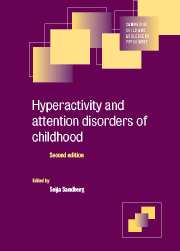Book contents
- Frontmatter
- Contents
- List of contributors
- Preface
- 1 Historical Development
- 2 Epidemiological aspects: what have we learned over the last decade?
- 3 Cross–cultural/ ethnic aspects of childhood hyperactivity
- 4 4 Sex differences and their significance
- 5 Classification issues
- 6 The role of attention
- 7 Cognitive aspects and learning
- 8 Developmental perspectives
- 9 Behavioural and molecular genetic studies
- 10 Biological underpinnings of ADHD
- 11 Psychosocial contributions
- 12 Institutional care as a risk factor for inattention/overactivity
- 13 Treatments: The case of the MTA study
- 14 Attention feficit hyperactivity disorder in adults
- Index
14 - Attention feficit hyperactivity disorder in adults
Published online by Cambridge University Press: 28 August 2009
- Frontmatter
- Contents
- List of contributors
- Preface
- 1 Historical Development
- 2 Epidemiological aspects: what have we learned over the last decade?
- 3 Cross–cultural/ ethnic aspects of childhood hyperactivity
- 4 4 Sex differences and their significance
- 5 Classification issues
- 6 The role of attention
- 7 Cognitive aspects and learning
- 8 Developmental perspectives
- 9 Behavioural and molecular genetic studies
- 10 Biological underpinnings of ADHD
- 11 Psychosocial contributions
- 12 Institutional care as a risk factor for inattention/overactivity
- 13 Treatments: The case of the MTA study
- 14 Attention feficit hyperactivity disorder in adults
- Index
Summary
This chapter will review the developing concept of adult attention deficit hyperactivity disorder (ADHD) as it has evolved through changes and modifications in the classificatory system. The most convincing evidence of symptom persistence into adult life and of new patterns of adult comorbidity comes from the longitudinal follow-up studies of childhood hyperactivity and these will be considered in some detail. The chapter will conclude with a section on treatment and management. Diagnostic and Statistical Manual of Mental Disorders, 4th edition (DSM-IV: American Psychiatric Association, 1994) uses the diagnostic term ADHD; International Classification of Disease (ICD-10) (World Health Organization, 1992) uses hyperkinetic disorder (HD). In essence these terms refer to the same disorder, although the differing criteria will identify distinct though overlapping patient populations. In this chapter ADHD rather than ADHD/HD will be used for simplicity; it should not be taken to imply any classificatory preference on the part of the author. The central concept of what is now referred to as ADHD (DSM-IV) or HD (ICD-10) has undergone several transformations, in the course of which a recognition that features may persist into adulthood has gradually emerged. Minimal brain damage, an overarching clinical concept, embraced a number of distinct disorders and syndromes that have since been disaggregated; these included ‘impairment. . . of attention, impulse, or motor function’ (Clements, 1966). DSM-II recognized hyperkinetic reaction of childhood (or adolescence) as a distinct entity characterized by overactivity, restlessness, distractibility and short attention span. Impulsivity was no longer included.
- Type
- Chapter
- Information
- Hyperactivity and Attention Disorders of Childhood , pp. 468 - 490Publisher: Cambridge University PressPrint publication year: 2002



